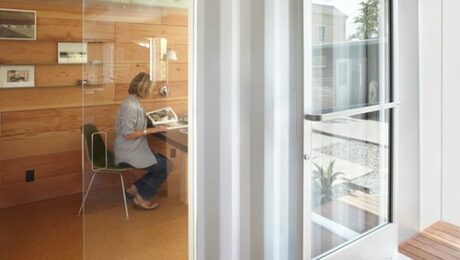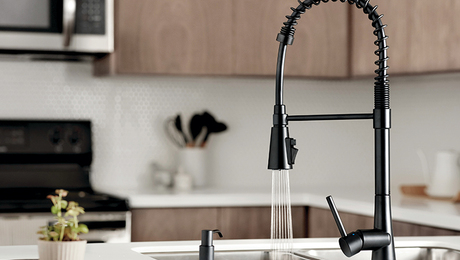Pad for Heat Pump Condenser
Hello,
I’m planning to have a heat pump (ducted heat pump) installed soon.
my HVAC installer wants to put in a plastic (might be rubber, something like that) pad under the outdoor unit.
I talked to another person who seemed to think that was nuts–ALWAYS use a concrete pad.
But a couple of quick searches yields the fact that a concrete pad has it’s own problems: could tilt or crack if not built right, also doesn’t absorb sound the same way so might end up being noisier.
I like to find the “right” answer, but in this case, is there a preferred approach?
Or just two methods that each have their pros & cons?
If I provide a tamped gravel base for a rubber or plastic pad, is that just as good as a concrete base?
Thanks!
GBA Detail Library
A collection of one thousand construction details organized by climate and house part









Replies
I’m not a fan of the composite bases. Concrete will be better for sound control too — the base doesn’t “absorb” any sound, but the mass of concrete does help to damp vibrations. Lightweight materials won’t work as well.
You can use large precast pavers to make bases for some of the smaller units. I would do that before going with a composite base, but a regular 4” concrete pad would be my preference.
Bill
ok thank you Bill!
I used a snow stand with 4 feet and put a paver under each. This way I can always re-level it if the ground heaves.
That's what I did as well. I used 4x12 solid concrete blocks and used 3 large concrete anchors on each leg stand. I then put white crushed stone over the blocks under the unit.
thanks Kyle. Is a snow stand something like one of these?
https://www.google.com/search?q=snow+stand+for+heating+unit&rlz=1C5CHFA_enUS923US923&oq=snow+stand+for+heating+unit&aqs=chrome..69i57j33i160.3249j0j7&sourceid=chrome&ie=UTF-8
BFW577 has a good picture above.
Throwing a different perspective into the mix.
I built what I'm calling a condenser deck. I used four of these Simpson EZ Spikes:
https://www.strongtie.com/fences_decksandfences/ez_spike/p/e-z-spike
I'll have to get pictures later, but I used 4x4 posts cut to 16", then added treated 2x6 "joists" to make a small deck frame. I wanted to elevate the unit off the ground, and I've been avoiding concrete as much as I can.
It was easy, relatively inexpensive, provided a solid platform. I'd do it again for sure.
Wow I would see building a small wooden platform on a tamped gravel pad, and avoiding concrete that way also. I am wondering whether people who are raising their units are doing so because of snow? Snow is almost a non-issue here.
Also - are the units bolted down to whatever they sit on?
Snow stands exist to elevate units above snow level so that vents don’t get plugged up in wither time. They are also helpful in areas prone to flooding to keep equipment up above any standing water you may have during or after storms.
I would stick with concrete or precast pavers here. You really want to mass of those materials to keep the unit stable, and to help avoid any resonances that will increase noise levels.
Bill
Paula,
I raised my unit for a few reasons, one is snow, and the other is that just like Zephyr7 below states, for standing water. That part of my hard tends to hold water a bit more, and I wanted to keep it out of it.
I definitely bolted the unit to the wooden frame. I used isolators made from a rubber composite, and through bolted them, rather than just screwing into them.
Zephyr7 is right about the mass element, but in my situation, noise really isn't a concern, and when it's running, it's very smooth, with little to no vibration.
I like my solution, but there are definitely a few ways to solve it.
If you bolt through the rubber, it won’t work as well due to the rigid connection. You can get vibration isolators that are rubber with threaded studs in either end that avoid this problem. McMaster carr is one source.
Bill
The additional electric path from wired house ground to the AC case to earth (ie, a non single point ground) provided by a wet concrete pad increases the risk of ground-potential-rise lightning damage. Avoid it - but no idea how much weight to put on this. Certainly more with the increased use of electronics in inverter heat pumps.
These are minimal cost, maybe worth using with concrete pads to electrically isolate the AC case from earth:
https://www.galco.com/buy/NVENT-ERIFLEX-ERICO/559698
It’s against code to add an additional ground rod like this. If you add any additional ground rods, you are required by code to bond (connect) them all together, and they all have to tie back to the primary ground for the structure at the service entrance.
Separate ground paths can and do cause damage in the case of direct or nearby lightning strikes. I have seen the damage before more than once, and the telecom world places a LOT of emphasis on proper grounding for this reason.
I wouldn’t bother with insulators here. You won’t hurt anything if you use them — the chassis of the equipment should be grounded through the power cabling anyway — but they don’t really gain you anything, either, in this application.
BTW, glastic makes a lot of those insulators. They are available from many sources, possibly cheaper than Galco (who is one of my vendors).
Bill
What "additional ground rod"? But since you brought it up, NEC 250.54 (Auxiliary Grounding Electrodes) permits them without dedicated bond wires. But my point is to avoid this superfluous and occasionally dangerous earth connection in the case of residential AC - use only the normal ground wire that runs into the house and electrically isolate the pad/enclosure to NOT create an AGE.
https://www.youtube.com/watch?v=gg4wBI7bWgI
I looked up that exception since it's not something I normally work with. 250.54 still requires an equipment grounding conductor, so there would still be a conductive, wired, path between the main ground rod and the auxillary ground rod.
I would ABSOLUTELY NOT EVER add a ground rod like this. Fault currents from lightning strikes can be huge (I design for 100,000 amp strikes at work), and can fuse open smaller conductors (we typically use 6 gauge solid copper as a minimum). You're adding a lot of of potential risk with an auxillary ground rod and not really gaining anything in a situation like this.
If you're in a high lightning area (I am), I would put in a proper ground ring and be done with it. I've done that at my own home, and my previous home, and it saved my previous house when lightning took out an ~3 foot diameter oak tree that was around 6 feet from the house. We had almost no electrical damage to the home, the ground ring handled the fault current. We did have some mechanical damage to the roof from exploded pieces of oak tree (some were the size of 4x4s about 5 feet long, which were thrown several hundred feet from the tree and some embedded in the roof sheathing). The ground ring I use is a 2 gauge buried copper conductor with an 8 foot ground rod cadwelded to it every 16 feet. I tie everything into that ring -- utility ground points, metal well casing, anything conductive. The purpose of the ground ring is to protect everything inside of the "ring" formed by the wire. Such systems are very effective, but can cost several thousand dollars to install.
Bill
We have a setup with snow stands on composite pads. About 18 months in and can't say anything negative about those composite pads.
We have the same setup. After six years, plenty of snow and ice, no issues whatsoever.
We have the same stands, although bolted onto existing concrete apron. Same experience, they are great. Hey, we had over 8" of blown snow in freaking Austin TX last year and these purred along. Also great for leaves getting blown in under and the units generate quite a lot of water, so I see loads of ground mounted units here with wet leaves constantly. Very hard to clear them out from under and the dripping water freezing seems like a bad idea.
Nice tidy installation.